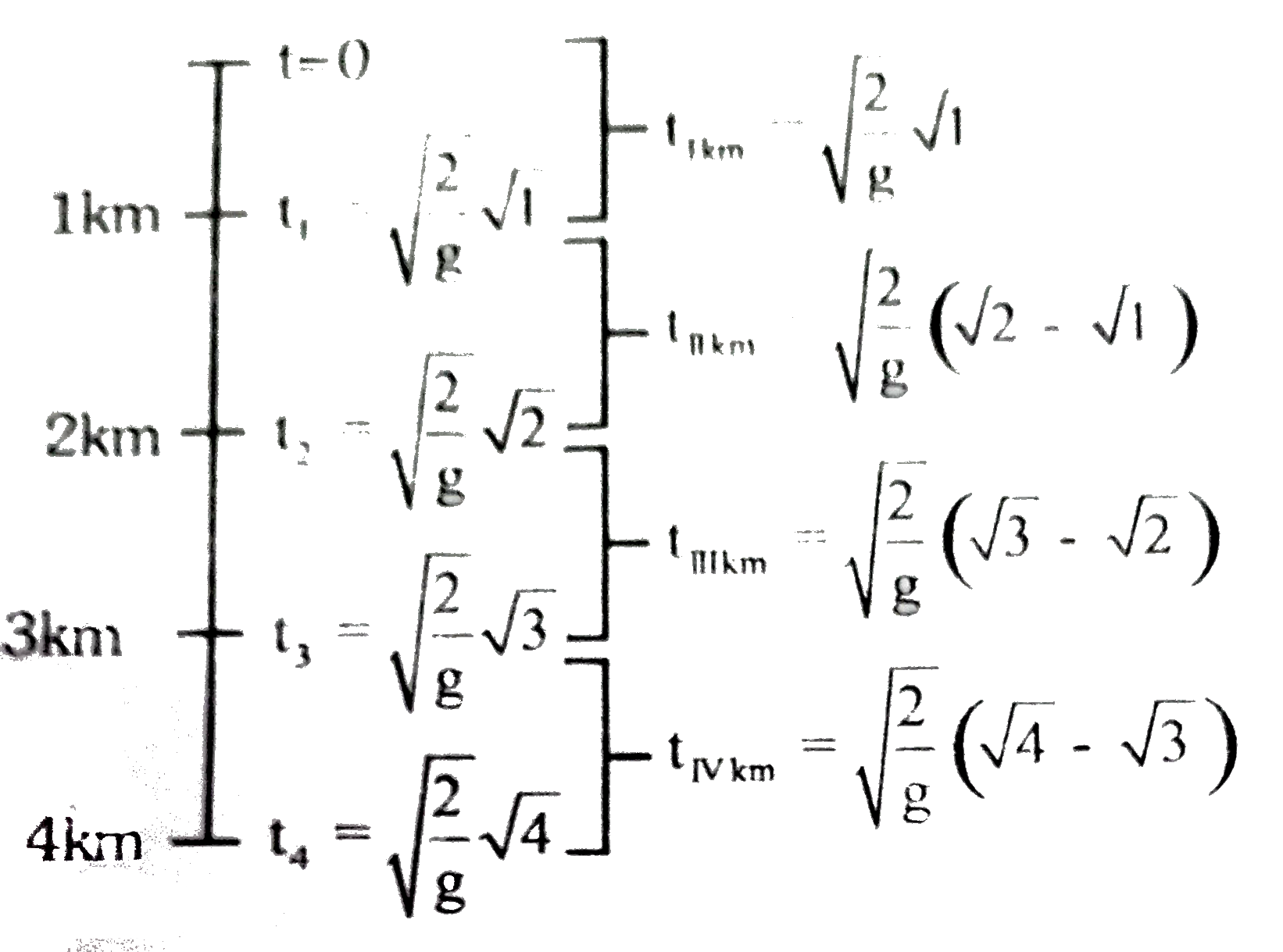A particle is dropped from rest from a large height Assume g to be constant throughout the motion. The time taken by it to fall through successive distance of 1m each will be :Solution in Gujrati
all equal, being equal to √2g second.
in the ratio of the square roots of the integers 1: √2:√3
in the ratio of the difference in the square roots of the integers,i.e.,√1,,(√2−√q),(√3−√2),(√4−√3)......
in the ratio of the reciprocals of the square roots of the intergers, ie., 1√1,1√2,1√3....
The correct Answer is:C
∵h=12gt2∴t=√2hg

Topper's Solved these Questions
- BOOK - ALLEN CHAPTER - MOTION IN A PALNEEXERCISE - EXERCISE-341videos
MOTION IN A PALNE
- BOOK - ALLEN CHAPTER - MOTION IN A PALNEEXERCISE - SOLVED EXAMPLE28videos
MOTION IN A PALNE
- BOOK - ALLEN CHAPTER - MOTION IN A PALNEEXERCISE - EXERCISE-199videos
MOTION IN A PALNE
- BOOK - ALLEN CHAPTER - KINEMATICS-2DEXERCISE - Exercise (O-2)47videos
KINEMATICS-2D
- BOOK - ALLEN CHAPTER - NEWTON'S LAWS OF MOTION & FRICTIONEXERCISE - EXERCISE (JA)4videos
NEWTON'S LAWS OF MOTION & FRICTION
Similar Questions
Assertion : A body can have acceleration even if its velocity is zero at a given instant of time.
Reason : A body is momentarily at rest when it reverses its direction of motion.06:06View SolutionA particle thrown over a triangle from one end of a horizontal base falls on the other end of the base after grazing the vertex. If αandβ are the base angles of triangle and angle of projection is θ, then prove that (tanθ=tanα+tanβ)
07:34View SolutionThe distance x of a particle moving in one dimensions, under the action of a constant force is related to time t by the equation, t=√x+3, where x is in metres and t in seconds. Find the displacement of the particle when its velocity is zero.
01:34View SolutionA particle is moving in xy-plane .At certain instant the components of its velocity and acceleration are as follows ux=3m/s,uy=4m/s,ax=2m/s2anday=1m/s2. The rate of change of speed at this moment is
03:03View SolutionA piece of wire is bent in the shape of a parabola y=kx2 (y-axis vertical) with a bead of mass m on it. The bead can slide on the wire without friction. It stays at the lowest point of the parabola when the wire is at rest. The wire is now accelerated parallel to the x-axis with a constant acceleration a. The distance of the new equilibrium position of the bead, where the bead can stay at rest with respect to the wire, from the y-axis is:
02:48View SolutionA particle is dropped from rest from a large height Assume g to be constant throughout the motion. The time taken by it to fall through successive distance of 1m each will be :
04:05View SolutionA particles is dropped from certain height. The tame taken by it to fall through successive distance of 1 m each will be
05:10View SolutionA small drop of water falls from rest through a large height h in air, the final velocity is
10:27View SolutionA stone is allowed to fall freely from rest. The ratio of the time taken to fall through the first metre and the second metre distance is
02:47View SolutionThe ration of the distance traversed, in successive intervals of time by a body, falling from rest, are
View SolutionA particle is dropped from rest vertically from a height The time taken by it to fall through successive distances of 1 m cach will then be :
03:23View Solutionh ऊँचाई से एक कण को स्थिरावस्था से गिराया जाता है। एक-एक km की क्रमागत दूरियों को तय करने में लगे समयों का अनुपात होगा :
04:11View SolutionFrom a height, a particle falls from the break. It will take time to fall continuously every 1 m distance.
08:51View SolutionA small drop of water falls from rest through a large height h in air, the final velocity is
04:21View Solutionकिसी मीनार से छोड़ा गया पिण्ड अपनी गति के अंतिम सेकण्ड में कुल ऊँचाई का भाग 7/16 तय करता है पिण्ड को गिरने में लगा समय है -
05:17View Solution

